Photos of Melbourne from the 1950s
Bourke StreetThe is of lunchtime crowds in Bourke Street. |
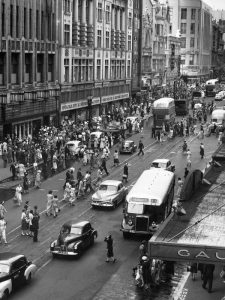 |
|
BreadA baker delivers a fresh loaf of bread in Dandenong in 1951. Per this website: “Growing up in the ’40s, ’50s and even ’60s often meant a daily visit from the baker by horse and cart. While now we’ve grown used to visiting the baker or supermarket to buy a loaf, it was originally hand delivered to each house, fresh from the oven. Some areas were still using horse and carts through to the early ’70s, before sliced and wrapped bread began to take off.” |
 |
|
ColesThe photo is of a Coles variety store in the early 1950s, with major brands being Starlet and Embassy. There was a cafeteria upstairs. Coles only began transitioning into self-service food stores (aka supermarkets) in the mid-1950s, when it started converting its stores into self service (“shop as you please then pay as you leave“). Its move into groceries began in 1958, when it took over the S.E Dickins chain in Victoria. It then opened its first supermarket in 1960 on the corner of Burke and Doncaster Roads in North Balwyn. |
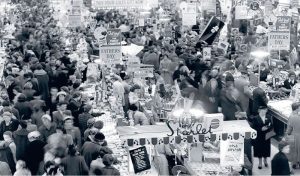 |
|
Expresso barThe photo is of an Italian migrant using a ‘new fangled’ coffee machine in 1955 in an espresso bar. Coffee has been a ‘thing’ in Melbourne since the 1870s but during and after WW2 people found a good coffee hard to come by because of shortages. Then, with the large influx of Italian migrants in the 1950s, came all of espresso coffees, espresso machines and espresso cafes. The first espresso machine arrived in 1954 as part of the first espresso cafe opening in Lygon Street, and the cafes quickly then flourished across Melbourne serving as both somewhere that migrants could socialise and a place of interest for Melbourne’s existing residents. Apparently, however, some (many?) people viewed the cafes as dens of iniquity. Then, in 1961, The Truth newspaper ran an expose on ‘espresso bar vultures’, alleging that espresso bars were being used as a cover for prostitution rackets. An interview with someone called ‘Jill’ was broadcast on radio and TV, where she outlined how she had been victimised by teenage prostitution gangs in the city’s espresso bars. Eventually, however, it was revealed that ‘Jill’ made up her story at the behest of police and the press. Read more. From the 2011 Census, around 70,000 Melburnians were Italian by birth and 280,000 were Italian by heritage. The highest concentrations were in Carlton and, within this, in Lygon Street. |
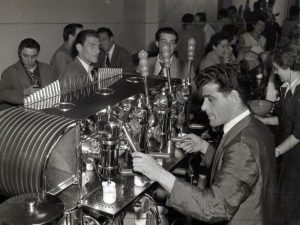 |
|
Flinders and Russell streetsThe photo is from the Yarra towards the corner of Flinders and Russell streets in the early 1950s. The tallest buildings at the time were St Paul’s and St Patrick’s cathedrals. All other buildings had to conform to the 40 metre height limit introduced in 1916 (equivalent to around 16 stories) and the Manchester Unity building, Rialto building and Russell Street Police Station were all roughly this height (excluding spires). The height limit began to be eased in the second half of the 1950s. The tallest current building is, at 317 metres, a residential building called Australia 108. |
 |
|
Flinders Street stationThe photo is of the 100th anniversary of Flinders Street station in 1954. Note that the anniversary is of the existence of a station at the site, not the building itself (which was built in 1910). The original station, which was opened in 1854, was merely a collection of weatherboard sheds and was called the Melbourne Terminus. It was the first steam rail station in Australia and the line from it was 4km long, ending in Port Melbourne (then called Sandridge). |
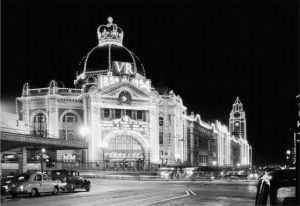 |
|
MarblesThe photo is of some children playing marbles in 1958. In the photo, a circle around 1 metre wide has been drawn. Each child has placed a couple of marbles within the circle and each has a larger marble – their shooter – in their hand. When it’s your turn, the aim is to use your shooter to knock out the other marbles. The game ends when all the marbles are out of the circle and the winner is the one with the most marbles at the end. If you are playing for ‘keepsies’, then you get to keep these marbles. |
 |
|
MilkThe photo is of someone called Dave Stephens delivering milk in Tottenham in 1955. Note the use of glass bottles. According to the Australian food timeline website, single-use paper cartons didn’t come into use in Melbourne until the 1970s. By 1987, only 2% of milk was being sold in glass bottles. For sustainability reasons, however, re-usable glass bottles have recently been making something of a comeback in Melbourne (e.g. Schulz at Eltham Farmers’ Market and elsewhere). Mr. Stephens was known as the flying milkman because he was a long-distance runner as well as a milkman. Indeed, he set the 6 mile world record in 1956. Ron Clarke, who witnessed the event as a 17-year-old, was quoted as saying “Subconsciously, watching Stephens’ races helped me come to the decision to compete as a club athlete instead of continuing to play cricket.” Mr. Stephens competed in the 10,000 metres (which is 6.2 miles) in the 1956 Melbourne Olympics but he had a heel spur injury at the time and only finished 20th. |
 |
|
Mont Albert NorthThe photo was sent in by Lyndell Whiting who wrote: “Here is photo taken from the front yard of the house that I grew up in, at Orchard Crescent, Box Hill North (now known as Mont Albert North), around 1951. The street name was very apt, as there were many orchards across from Koonung Creek. The hill on the horizon, straight above the house on the right, is where Westfield Shopping Centre is now located (I think). In any case, we could see it from our house when it was built. There was a dairy on that hill, on the corner of Tram Road and Doncaster Road, from where our milk was delivered by a Clydesdale horse pulling a cart.“ |
 |
|
OlympicsThe photo is members of the media in the MCG’s media room during the 1956 Olympics. The 1956 games were the first Olympic Games with live television broadcasts. But they were only test transmissions (albeit on all channels) and there were only around 5,000 television sets in Australia at the time. Here is an example clip. |
 |
|
Pogo sticksThe photo is of a group of friends in Cheltenham on pogo sticks in 1955. The pogo sticks in the photo have a single, upright vertical handle, which apparently posed something of a risk to the user’s chin. Later pogo sticks had a T-shaped double handle. |
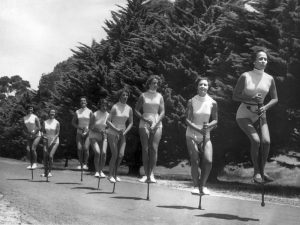 |
|
Queen ElizabethThe photo is of crowds lining Bourke Street when Queen Elizabeth arrived at Parliament House in 1954. In total, nearly a million people lined the roads from the airport to the CBD. |
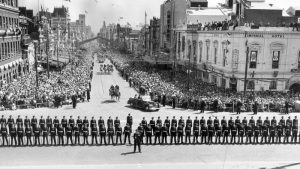 |
|
Royal Exhibition BuildingThe photo is of the Royal Exhibition Building in 1953. The Royal Exhibition Building was originally built in 1880 and it was built to host the Melbourne International Exhibition. During the first half of the 20th Century, the building was left to decay and, by the 1950s, it had become earmarked for replacement by office blocks. After Melbourne City Council narrowly (by one vote) decided not to demolish the building, it was used for the 1956 Summer Olympics as well as for regular dances and various shows. In 2004, the building and associated gardens were listed as a World Heritage Site, the first building in Australia to be granted this status. It is one of only two World Heritage Sites in Victoria, the other being Budj Bim, which is a dormant volcano near Macarthur in south western Victoria. |
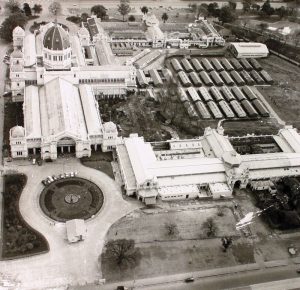 |
|
Swanston StreetThe photo is of a view down Swanston Street in 1955, looking south towards the Shrine of Remembrance. The photo has been taken with a telephoto lens which makes the background seem much closer than it actually is. Obviously, the photo has been taken south of Franklin Street, which is where Swanson Street bends, and is perhaps from near the intersection with Little Bourke Street. |
 |
|
SwimmingThe photo is of children being taught to swim under the Herald Learn-to-Swim program in 1958. The learn-to-swim program was introduced by the Melbourne Herald newspaper in 1929. Young Victorians were given their ‘Herald’ certificate if they could swim 25 yards (23 metres). The program ended in the late 1980s, perhaps when Rupert Murdoch purchased the paper. |
 |
|
Syd Palmer’s big bandThe photo is of Syd Palmer’s big band playing at Heidelberg Town Hall. Per the 1950’s Melbourne website: “The social life of most young people in 1950s Melbourne centred around the Saturday night dances. In the early 50s, dances were prescriptive: Pride of Erin, fox trot, barn dance and such, all followed by the compulsory waltz at the end of the night. It was expected that the band would play Lullaby of Birdland and When the Saints Go Marching In at some point in the evening. Men and women often congregated separately, with the women seated around the walls and the men clustered at one end before venturing out when the music started to invite a woman to dance.” Nillumbik U3A Michelle Rowsell has written in to say that Syd was her great uncle and that she used to attend many of the dances at Heidelberg Town Hall for free. “They were so much fun.“ |
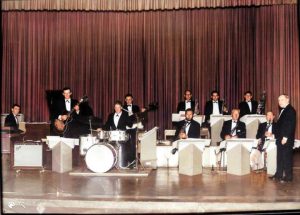 |
|
Toorak RoadBoth photos are of Toorak Road, the lefthand one being from 1950 and the righthand one being from 1957. If these photos are at all representative, the cars in Melbourne changed a lot during the 1950s. |
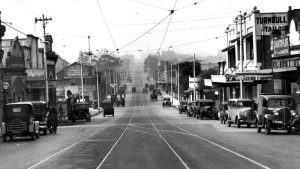 |
 |
Washing machineThe photo is of a group of shoppers looking on at a washing machine demonstration. The first automatic washing machine was apparently invented in the USA in the late 1930s. For obvious reasons, production of machines was suspended during World War II but, less obviously, research and development was allowed to continue. The result was that there were numerous machines becoming available in the late 1940s which, in turn, made their way to Melbourne in the 1950s. |
 |
|
